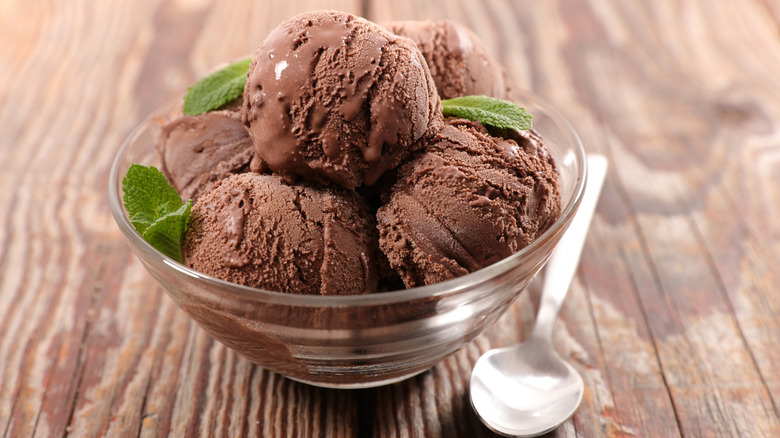What You'll Typically Find In Nancy Pelosi's Polarizing Diet
Nancy Pelosi made history in 2007 as the first woman elected Speaker of the U.S. House of Representatives. Although she has represented her San Francisco district for more than 37 years, you can't assume she sticks to a stereotypical California diet of Buddha bowls and green smoothies. After all, Pelosi grew up in Baltimore.
What's often on the slim, 85-year-old Speaker Emerita's daily menu might actually surprise you. During the COVID-19 pandemic, The Late Late Show with James Corden's "Show and Tell" segment featured Pelosi in her San Francisco home. She pulled out a huge basket of Easter candy, then opened her freezer to reveal it stuffed with Dove ice cream bars, Talenti gelato, and pints of Jeni's ice cream.
Although she was isolating like many others in April 2020, Corden asked how much of her diet consisted of ice cream and candy. "As much as possible," she replied. "I like it better than anything else. And I don't know why, but it seems to agree with me. I have a lot of energy."
Pelosi even told "The River Cafe" podcast in 2022 that she still eats ice cream for breakfast. You might think she cuts back on junk food at lunch, but not exactly. She ended one interview with The Wall Street Journal with what she called her typical lunch — a hot dog with mustard and relish.
Pelosi has ice cream for breakfast?
With so many dietitians and health professionals emphasizing breakfast as the most important meal of the day, they also stress that it should be nutritious. Ideally, breakfast should be low in added sugars, which can cause your blood sugar to spike and crash a few hours later—leaving you running for the vending machine or a sugary Starbucks pumpkin spice latte. A nutritious breakfast will include protein, fiber, complex carbs, and maybe a little healthy fat.
Pelosi says ice cream isn't always on her breakfast table, but she appreciates the convenience. "It's right there and has a long shelf life," she said on the "Ruthie's Table 4" podcast. "I don't have to worry about it. It's a great way to start the day."
(Read what happens when you eat ice cream every day.)
Starting your day with a serving of Jeni's Darkest Chocolate ice cream isn't too alarming in terms of calories, coming in at 300 for a ⅔-cup serving. But the added sugar might give you pause with 24 grams — almost half the recommended daily limit. It also packs 10 grams of saturated fat, which is around half of your daily allowance. Still, chocolate ice cream isn't entirely without merit. You'll get 4 grams of fiber to help keep you full and more than 600 milligrams of potassium.
A hot dog a day raises your risk of diabetes and cancer
Hot dogs aren't exactly a premium protein source. Hot dogs are made from a mix of animal muscle and byproducts such as heart, liver, or kidney. These ingredients are ground into a paste, then combined with fat, corn syrup, water, and other additives before being stuffed into casings. Most hot dogs are also cured with sodium or potassium nitrate.
A standard 57-gram hot dog without the bun or condiments contains about 177 calories and 6.5 grams of saturated fat. It's also relatively high in sodium, with 472 milligrams per serving. While you do get nearly 7 grams of protein, a hot dog offers no fiber, which means it might not keep you full for long. A hot dog does provide some vitamin B12, but otherwise, its nutritional value is limited.
Eating a hot dog every day may even harm your health. According to a 2025 article in Nature Medicine, consuming up to 57 grams of processed meat per day is linked to an 11% higher risk of type 2 diabetes and a 7% higher risk of colorectal cancer. Even consuming less than a gram of processed meat daily was associated with an increased risk of these conditions.


